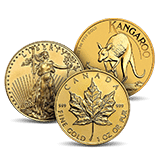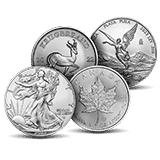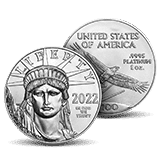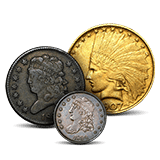
Error coins are unintentional yet highly collectible and sometimes valuable products of the minting process. From misaligned dies to off-metal planchets, these offer historical intrigue and substantial market value, especially among the most valuable error coins. Collectors delight in these oddities for their rarity, storytelling value, and insight into U.S. Mint operations.
The Most Valuable U.S. Error Coins
1. 1943 Copper Penny
Type: Off-metal planchet (copper instead of steel)
Estimated Mintage: 40
Graded Population: Extremely rare in Mint State
Auction Range: $100,000–$372,000+
Struck by mistake during WWII on leftover 1942 copper planchets, this transitional error is one of the most famous in U.S. coinage. While 40 were produced, a mere 27 remain today. Legitimate examples in MS-64+ have sold for over $300,000, with one 1943-D cent commanding a $1.5 million price tag. Widespread counterfeits exist, so authentication is essential.
2. 1974 Aluminum Penny
Type: Experimental composition (not released)
Estimated Mintage: Approximately 1.5 million struck, fewer than 10 surviving
Graded Population: None publicly certified
Estimated Value: $250,000+ (private)
These coins were trial strikes for alternative compositions due to rising copper costs. Most were destroyed, and the few survivors remain in legal limbo, with at least one returned to the Mint. This coin is considered “unauthorized” by the government, and ownership is disputed.
3. 1958 Doubled Die Lincoln Cent
Type: Dramatic obverse doubling
Estimated Mintage: Likely fewer than 3–4 known
Graded Population: Unlisted by PCGS/NGC
Auction Range: $100,000+
A near-mythical piece in Lincoln cent collecting, this coin exhibits strong doubling and remains one of the rarest known U.S. doubled dies. One in MS-64 condition was sold for more than $300,000.
4. 1969-S Doubled Die Lincoln Cent
Type: Obverse doubling
Estimated Mintage: Approximately 100
Graded Population: Scarce in MS-65+
Auction Range: $40,000–$75,000
Bold doubling on the date and inscriptions led early experts to suspect counterfeiting. After authentication, it became one of the most sought-after Lincoln errors of the 20th century.
5. 1955 Doubled Die Lincoln Cent
Type: Dramatic obverse doubling
Estimated Mintage: Around 24,000
Graded Population: Common in circulated condition, rare in MS-65 and above
Auction Range: $1,000–$50,000+
Perhaps the most recognizable U.S. error, this coin shows heavy doubling visible without magnification. High-grade Mint State examples remain elusive and command serious premiums. The 1955 Doubled Die Wheat cent is one of the three rarest wheat pennies.
6. 1944 Steel Penny
Type: Transitional off-metal error
Estimated Mintage: Fewer than 30
Graded Population: Very few in MS-65+
Auction Range: $30,000–$75,000
Struck by accident on leftover 1943 steel blanks after the return to copper. These pennies are rare relics of wartime minting transitions.
7. 2000 Sacagawea “Cheerios” Dollar
Type: Die variation (enhanced eagle feathers)
Estimated Mintage: 5,500
Graded Population: Fewer than 150 certified
Auction Range: $5,000–$10,000+
Part of a Cheerios cereal box promo, this variant features an early prototype reverse with detailed eagle feathers, later replaced in circulation strikes. It was discovered by collectors years after release.
8. 1992 Close AM Lincoln Cent
Type: Design mismatch (proof reverse on circulation strike)
Estimated Mintage: Unknown
Graded Population: Limited in higher Mint State grades
Auction Range: $5,000–$10,000+
This variety shows the letters “A” and “M” in “AMERICA” nearly touching, which is unusual for pennies from 1992. This error is rare and difficult to find in high grades. Also exists in a 1992-D version.
9.1982 No P Roosevelt Dime
Type: Mint mark omission
Estimated Mintage: Approximately 150,000
Graded Population: Several hundred in MS-66
Auction Range: $500–$1,000+
Due to a die error at the Philadelphia Mint, some dimes were struck without the “P” mint mark. This was the first modern mint mark omission after the mark’s reinstatement in 1980.
10. 1999 Wide AM Lincoln Cent
Type: Design mismatch (proof reverse used in circulation)
Estimated Mintage: Several thousand
Graded Population: Common; but higher grades are desirable.
Auction Range: $500–$1,000+
A reverse design meant for proof coins was mistakenly used on regular business strikes, creating visible spacing between the “A” and “M” in “AMERICA.”
Key Error Coin Attributes
| Coin Name | Error Type | Estimated Mintage | Graded Population | Value Range | Notability |
| 1943 Copper Penny | Off-metal planchet | < 25 | Very rare in Mint State | $100,000–$372,000+ | Iconic WWII mistake |
| 1974 Aluminum Cent | Experimental issue | < 10 surviving | None publicly certified | $250,000+ | Legally disputed test piece |
| 1958 Doubled Die Lincoln Cent | Dramatic doubled die | < 4 known | Not listed publicly | $100,000+ | One of the rarest U.S. errors |
| 1969-S Doubled Die Lincoln Cent | Obverse doubled die | ~100 | Scarce in MS-65 | $40,000–$75,000 | Once thought to be counterfeit |
| 1955 Doubled Die Lincoln Cent | Dramatic doubled die | ~24,000 | Common in circulated; rare MS | $1,000–$50,000+ | Most famous doubled die |
| 1944 Steel Penny | Transitional planchet | < 30 | Very few in high grades | $30,000–$75,000 | Wartime composition anomaly |
| 2000 “Cheerios” Dollar | Die variation | 5,500 | < 150 certified | $5,000–$10,000+ | Enhanced reverse from promo issue |
| 1992 Close AM Lincoln Cent | Proof reverse on regular | Unknown | Scarce in Mint State | $5,000–$10,000 | Rare design variety |
| 1982 No P Roosevelt Dime | Missing mint mark | ~150,000 | Several hundred in MS-66 | $500–$1,000+ | First major modern mintmark error |
| 1999 Wide AM Lincoln Cent | Proof reverse on regular | Several thousand | Common; Mint State issues are in demand | $500–$1,000+ | Popular and accessible modern error |
FAQs for New Collectors
What Is the Difference Between an Error and a Variety?
Error coins result from mistakes such as wrong planchets or doubled designs. Varieties arise from intentional changes or consistent die traits, like different spacing in lettering or mint mark styles.
Are All Error Coins Valuable?
Minor strikes or off-center coins might not hold much value unless they’re dramatic, rare, or tied to a major series. The biggest drivers are visual impact, scarcity, and collector demand.
Can I Legally Own All U.S. Error Coins?
Most are legal to own. However, coins like the 1974 aluminum cent exist in a gray legal area and may be subject to government reclamation.
From iconic wartime cents to obscure modern mismatches, U.S. error coins offer a rare glimpse into the unintentional stories behind our coinage. While some command six-figure auction prices, others are within reach for dedicated collectors.




